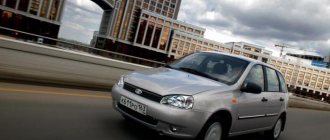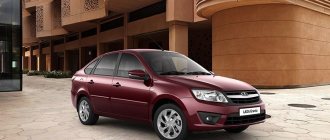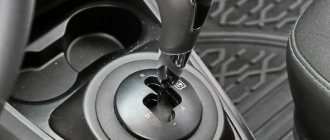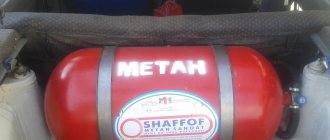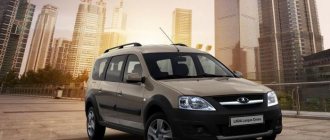"Lada-Kalina" is currently one of the most popular and frequently seen Russian-made cars on our roads. This model has been in production for the 13th year. The first car rolled off the assembly line in 2004, although the development of Kalina began back in 1993. The future new product has been designed and improved for more than ten years - it is not surprising that it has become one of the most anticipated AvtoVAZ models. Now many people own such a car. The Lada Kalina station wagon is especially popular. Reviews from owners are direct confirmation that this is a solid and functional machine. The model is indeed of particular interest, so it is worth paying a little more attention to this topic.
First generation
Before moving on to owner reviews of the Lada-Kalina station wagon, it’s worth briefly talking about the car itself. And we should start with the first generation.
The station wagon, which was assigned the index 1117, was released later than the sedan and hatchback. Its mass production began only in 2007. The car quickly gained popularity due to its capabilities related to cargo and passenger transportation.
Externally, the station wagon looks almost the same as the sedan and hatchback. But due to the monumental stern with a large luggage lid and unique lights, it looks more harmonious and proportional.
This model was offered with the following engines:
- 1.6-liter, 81 horsepower. Acceleration to 100 km/h in 13 seconds. Maximum – 165 km/h. Consumption in the city and on the highway is 9.8 and 6.2 liters, respectively.
- 1.4-liter, 89 hp. The indicators are similar, but the consumption is 1-2 liters less.
- 1.6-liter, 98 hp. Acceleration to 100 km/h in 7.2 seconds. Maximum – 183 km/h. Consumption in the city and on the highway is 11 and 8 liters, respectively.
As for capacity, the station wagon’s trunk can accommodate 430 liters of cargo. The volume can be increased to 500 liters by removing the rear parcel shelf.
What has changed in the second Lada Kalina
The marketers' games are in everything, starting with the name. In fact, we have before us a modernization of the first generation, but it is presented as the second. The fundamental units and platform remained the same, although they were upgraded. Therefore, it is more correct to talk about the deep, but restyling of the 2004 Kalina.
But whatever you call the update, the only important thing is that the car has changed significantly. And if you can argue in terms of design, then technically it has become more perfect. Gone is the crooked electric power steering, which on its predecessor often jammed and lived its own life, indistinct brakes and a lousy interior. The second “Kalina” became closer to the Koreans, even if it was at the beginning of the 2000s.
Also read: Lancer X - representative of the measured generation of Mitsubishi
Equipment
Good equipment is the first advantage that can be highlighted when reading reviews from owners of the Lada-Kalina station wagon.
The model was offered in three trim levels. The standard included steel wheels, halogen headlights, glazing with ultraviolet protection, bumpers painted in body color, an adjustable steering column, and central locking with remote control.
But that is not all. Also included in the list of basic equipment are front electric windows, door stiffeners, audio preparation, an immobilizer, an alarm system, a driver's kit (jack, wheel wrench, spare wheel), a notification about the need for diagnostics, and also a buzzer for an ignition key left, lights on, rear untranslated transfers.
The next configuration was called “norm”. The car in this version, in addition to the above, also had a mirror in the passenger sun visor, decorative wheel covers, climate control, and an audio system (FM+CD+MP3) with two speakers and an antenna.
In the luxury version, the car was additionally equipped with rain sensors, a curtain in the luggage compartment, an ABS system, a seat belt tensioner, driver and front passenger airbags, rear electric windows, heated seats and mirrors (with electric drive), and also fog lights. By the way, the wheels on the version with this configuration were fitted with light alloy wheels.
Considering all of the above, one can understand why the majority purchased the Kalina in a luxury version. The price difference at that time was approximately 70,000 rubles for a model with an 81-horsepower 1.6-liter engine.
Video Lada Kalina station wagon
Video review of Kalina in the “Standard” configuration.
Technical characteristics of Kalina 2022 model year
- Body length – 4084 mm
- Width – 1700 mm
- Height – 1504 mm
- Curb weight – from 1125 kg
- Gross weight – 1560 kg
- Wheelbase – 2476 mm
- Front and rear wheel track – 1430/1414 mm, respectively
- Trunk volume – 355 liters
- Trunk volume with seats folded – 670 liters
- Fuel tank volume – 50 liters
- Tire size – 175/65 R14, 185/60 R14, 185/65 R14, 185/55 R15,
- Ground clearance (clearance) – 160 mm (with automatic transmission 145 mm)
There is no need to be upset about the imminent transformation of the Kalina station wagon into the Lada Granta station wagon. After all, the machines are structurally similar, built on a common aggregate base. Moreover, the manufacturer promises an increase in loading space in the new Grant station wagon, which will replace the practical Kalina.
Subcompact version in use
Now we will talk about the Lada-Kalina 1.4 station wagon. The reviews left by owners about this version fully allow us to understand what this car is like.
Motorists pay special attention to the performance of the 89-horsepower engine. A car with such a unit drives briskly, but the engine loves high speeds, so at the bottom it is somewhat “thoughtful.”
What can you say about consumption? In summer, the on-board computer shows an average of about 6.5 liters per 100 kilometers on the highway (at a speed of 110-120 km/h); when driving around the city, consumption increases to 8.2 liters. With the air conditioner turned on, consumption increases, but not by much - by about 0.2-0.3 liters.
Consumption also depends on driving style. If you move along the highway at speeds of up to 90 km/h, the engine will consume even less than six liters. But in winter, of course, consumption increases. When driving around the city it is approximately 11 liters. On the highway - about 7-8 liters. By the way, owners recommend using 95-grade gasoline, since 92-grade gasoline is difficult to digest.
Owners pay special attention to the dynamics of this car. Compared to early VAZ models, this car is just a spaceship. In fact, it’s a station wagon with dynamics that provide quite comfortable driving around the city. But the reserve of the 1.4-liter engine is sometimes not enough even for those motorists who are not adherents of a harsh driving style. The engine is a compromise, with adequate fuel consumption, allowing you to stay in the flow and even overtake, but without reserve. Although on the highway a car with this engine behaves well. But only if there are no passengers in the cabin and no cargo in the trunk. Otherwise, many people get the impression that they are driving not a car, but a horse-drawn carriage.
Kalina II and amenities
In this case, convenience without quotation marks and irony, the VAZ team made several leaps forward. Firstly, in terms of workmanship. Secondly, for the convenience of the layout. Climate control unit, for example, like in the best houses! Three large, clear knobs with clear indication and clear activation of modes.
Or take instrument scales. There are few design delights, but the readability of the speedometer-tachometer and on-board computer is head and shoulders above other “Koreans”, if only due to the fact that there is no eye-catching orange or blue backlight.
The quality has been improved, the assembly of the interior looks neat, but many things remind us that this is, after all, Togliatti. For example, the door locks close with such a bang, as if the latches were not in place, and howitzers were working on you. Or the clicks of the relay when you press the power window buttons - this car constantly reminds you that it’s alive with its humming sound.
The option has almost caught up with budget competitors of famous brands. There is air conditioning, a set of airbags, remote door locking with a key, and Bluetooth. Older versions were equipped with a media processor of mediocre quality: no performance, the interface was confusing, the picture quality was the same as on pocket computers from 2005. This is the case when you can safely refuse and have nothing to lose.
There was no revolution in terms of passenger convenience. The wheelbase has not stretched compared to the first generation, and both rows are just as cramped. That is, a young family of three people, especially if the third is still in a cradle and not a chair, is still normal, but going to a barbecue with a group will not be fun.
Also read: Toyota Vitz II (XP90): All the pros and cons of the city weasel
Versions with a 1.6-liter unit
There are more owners of such modifications than people driving station wagons with the notorious 1.4 liter engine. What do they say about them?
Motorists characterize the 1.6-liter engine as a playful, noisy, and quickly gaining momentum unit, which begins to “eat well” after 3000 rpm. The thrust of this engine is more than enough to get moving from idle. But in terms of adding gas you need to be very careful. If you press the pedal to the floor, the wheels will slip. This is especially noticeable when starting on an incline. Gas must be dosed carefully even after switching to second gear.
But, in general, the 1.6-liter engine is capable of satisfying even high-speed enthusiasts. A car with such a unit, of course, is not intended for racing tracks, but the power of this engine is enough not only for everyday driving - the car feels confident on the track.
Consumption, as shown by reviews from owners about the Lada-Kalina station wagon, corresponds to the figures stated in the passport. Moreover, if you choose a gentle driving mode and stick to it consistently, you can further reduce consumption. Many motorists assure: consumption on the highway can be 4.8-5 liters, if you do not overestimate the speed. In the city the figure is stable - 7-8 liters per “hundred”.
Electronics operation
You can also learn a lot of interesting things about it by reading owner reviews of the Lada-Kalina (station wagon) with photos.
The operation of the air conditioner deserves special attention. Firstly, when you turn it on, you get the feeling that an anchor has been dropped on the asphalt. Management becomes more difficult. Because of this, many turn it on only in weather in which it is impossible without it.
Secondly, the air conditioning works very poorly. Thirdly, in order for it to somehow cope with its task, you need to regularly change the cabin filter, charge it with refrigerant and clean it.
You can also find many comments about the operation of the stove. Here the situation is better. The interior warms up quickly and well, but there is one thing. Side windows become chronically cloudy at temperatures below -20°C. And if in cold weather you direct the air in some other direction, the side mirrors are also lost. So you won’t be able to warm the windows and your feet at the same time. And the stove only works well at outside temperatures down to -30 °C.
Behavior on the road
It is described in detail by many owners of the Lada-Kalina station wagon. Reviews allow us to verify that the chassis of this car is quite acceptable in its characteristics for Russian roads. The car does not roll when turning, but it is not recommended to make sharp turns - it becomes scary. The suspension “swallows” medium-sized holes and bumps, but when passing serious obstacles you need to be extremely careful and reduce speed to a minimum.
The ground clearance of the station wagon is 16 centimeters, but it feels like it is even lower. However, this ground clearance is enough for driving around the city and light off-road.
The car's brakes are good, but somewhat weak. Some motorists changed the pads and fluid in the system, but even this did not achieve the desired effect. Apparently, this is the specificity of the Kalina brakes.
Many people call the seating “stool-like”, but it is more comfortable than in “tens” and “nines” (people who have something to compare with claim this).
Also, many motorists, when talking about this car, note its clear advantage over other models, which lies in its compactness. The station wagon measures 4,040 mm in length, 1,700 and 1,500 mm in width and height, respectively. These dimensions have made the Kalina a small and nimble city car that can easily squeeze through both courtyards and parking lots.
Pros and cons of Lada Kalina II
Compared to its predecessor, the quality has increased by an order of magnitude. The second Kalina was not noticed in scandals when, at speed, the EUR began to take on a life of its own, and the driver ended up in a tree on the side of the road.
Untreated problems include tight brakes and howling gearbox gears. About the first, other owners do not agree and say that you just need to get used to it. No, it’s not necessary: the Kalina’s brakes are tight, the force that needs to be applied to the pedal is inadequate. Their classmates' braking is cleaner, more transparent and more effective. As for the howl of the gearbox, no matter how many gear options the VAZ team tried, it didn’t get any better, because it’s some kind of damned unit.
The rest of children's ailments are more unique and lottery. Also, cars under warranty had complaints about moldings coming off, problems with electrical and thermostat.
The main disadvantage of the Lada Kalina is the electrics. The problem with ignition coils on cars of the first years of production was solved by the manufacturer himself, changing the supplier from SOATE to Dynatec. The second problem is the central unit of body electronics, which is responsible for almost everything: from wipers and turn signals to interior lighting. AvtoVAZ even announced a recall campaign and reflashed these units or replaced them with new ones. But there is a risk of running into an unaltered one on the secondary market.
The standard multimedia systems were also reflashed under warranty. They are based on a very ancient OS based on Windows CE, so they slowed down mercilessly. After the patch it got better, but not much.
There were no complaints regarding the engine and transmission. And the suspension is durable, and the body is durable and resistant to corrosion. And one more advantage is mass availability. There is plenty to choose from.
Also read: What's wrong with the Mercedes Benz S-class AMG V limousine?
Second generation
In 2013, production of the most affordable Kalina station wagon was launched. This version was already equipped as standard with a driver's airbag, front electric windows, audio preparation, heat-absorbing windows, and electric power steering.
A new unit was installed under the hood of this model - an 8-valve 1.6-liter engine producing 87 horsepower. Its feature was a lightweight connecting rod and piston group.
Why was this model called the most affordable station wagon? Because its price was 330,500 rubles.
A year later, the Lada-Kalina Cross station wagon was released. Feedback from owners about this model makes it clear that it differs from the regular version in appearance, with a stiffer suspension and “longer” gears. This modification also received a ground clearance increased by 2.3 centimeters.
It is also worth noting that with the release of the second generation models, versions with a 1.6-liter 106-horsepower engine appeared. The maximum maximum speed of a car with such a unit is 177 km/h. At the same time, it accelerates to “hundreds” in 11.2 seconds and consumes about 6.7 liters in the combined cycle.
History of the development of the new Kalina-2
The station wagon body (as well as the hatchback) was created on the basis of molds specially ordered in Japan. Seven new molds were produced for almost a year, which, given the short time frame for re-equipping the conveyor, is quite a long time.
Several enterprises in the Samara region are engaged in metal processing for the production of Kalina-2. For stamping small parts, a technological equipment plant in Tolyatti and a joint company with Spain, Gestamp, located in Kaluga, are involved.
The new Kalina is equipped with a modified suspension from Granta, but the most serious changes were improvements to the compression buffers. For a long time, engineers selected the shape and level of rigidity. As a result, it was even decided to change the main supplier. When refining the chassis, the rear engine mount was also replaced and the exhaust system was modernized, which made it possible to achieve quieter operation of the power plant.
The climate control system of the new Kalina received controlled dampers so that the speed and direction of air masses could be automatically controlled. The multimedia system has a pre-installed Windows SE operating system, the software is actually paid, but the Navitel navigation system used previously was free.
Something interesting about the design features. Depending on the configuration, different suspension designs are used. On cars with a manual transmission, there is a standard front suspension with springs from Granta; on versions with an automatic transmission, springs from the “Sport” modification are installed. Thus, the loading height of a car with an automatic transmission is 15 mm less than the loading height of a car with a manual transmission, and this is due to stiffer springs.
Often, owners of first-generation Lada Kalina cars complained about the too short service life of lighting elements and failures of power windows. During the production of Kalina-2, suppliers of lighting elements and electrical equipment were replaced. In addition, the procedure for replacing headlight bulbs has been simplified. You no longer need to remove the entire headlight unit for such a simple job.
The front seats in the first editions differed depending on the selected configuration. For example, the “Lux” modification uses more expensive and high-quality upholstery. New Kalina consists of more than 20% foreign-made components.
About versions with a 106-horsepower engine
As reviews from owners show, the 2nd generation Lada Kalina station wagon has become more functional and technically attractive than its predecessors. In addition, versions with a powerful 106-horsepower engine appeared! It is logical that most car enthusiasts began to buy this version.
And the difference between this engine and previous units is really visible. It is especially noticeable at low speeds. The 106-horsepower engine pulls excellently and is quieter than other engines, even at high speeds. Consumption is not very high - about 10 liters in the city, and about 8 liters on the highway.
The gearbox is cable-driven - the gears are somewhat long, and the clarity is worse than on foreign cars. However, the box is still much nicer than its predecessors.
But what the owners who leave reviews like most about the Lada-Kalina-2 station wagon is the suspension. They note its balance. It “swallows” uneven spots and holes unnoticed. Those who have something to compare with say that even on some foreign cars the suspension is not that good.
Automatic transmission
It is impossible not to pay attention to the automatic version when studying the owner reviews left about the car in question. The Lada Kalina station wagon with automatic transmission is an excellent option for the city. This is what all the people who purchased it say. It’s especially pleasant to be behind the wheel of such a car after a manual transmission. But! If you carefully study the owner reviews of the Lada-Kalina station wagon with an automatic transmission, you can conclude: people who switched to it from a foreign car with an automatic transmission are not delighted. However, others advise just driving for a few days to get used to the specifics of Russian-made AMT.
And the peculiarity of the VAZ automatic transmission is the periodic illogical switching. Sometimes gears change at moments when the driver himself would not do this. But still, the majority is of the opinion that the automatic transmission in this car is not bad. Paired with the engine it works great, providing good dynamics. And there are no jerks, which is the most important thing.
However, the owners of the Lada-Kalina-2 AMT station wagon note some shortcomings in their reviews. It consists of an inconveniently located dipstick for checking the oil level in the gearbox - under the air filter.
What about service? Official information says that this “automatic” (Jatco JF414E) does not need it. But motorists recommend updating the oil every 30-45 thousand kilometers using the partial replacement method (without removing the pan).
Flaws
They are worth talking about separately. The shortcomings in the reviews of owners of the Lada-Kalina station wagon are often mentioned. They concern basically the same points.
- “Crickets” in the cabin are the first negative, the mention of which is found in all reviews of owners of the Lada-Kalina station wagon. The 1st and 2nd generations are guilty of “crickets”. The use of cheap materials in finishing has an effect. Often there is a strange clanging sound from somewhere under your feet and the rattling of the gearshift lever. Many people eliminate them using electrical tape, periodically tightening the nuts and screws.
- Unreliable spark plug modules installed on a 16-valve engine. The replacement frequency is once every 10,000 kilometers, and this is too often.
- Sensors Unreliable, just like the notorious spark plug modules.
- Light bulbs. To replace them, you need to try hard and spend a lot of time. Perhaps owners of flexible hands have an easier time.
- Capacity. Questions to this point are found in every review from owners of the Lada-Kalina station wagon. The disadvantages listed above, in principle, do not cause surprise, except for the capacity. After all, this is a station wagon, which means there should be enough space in it for both passengers and large cargo. But no. Even according to the passport, the maximum permissible load is limited to 475-500 kilograms. So the station wagon here is just a name and a body, but not functionality. And the owners of the Lada-Kalina station wagon who leave reviews call this the main drawback.
Advantages
Many advantages of this car have already been mentioned above. But now it’s worth summarizing them.
- A significant advantage is the low price of the car. It is mentioned in all reviews of owners of the Lada-Kalina station wagon. Luxury equipment - and it is inexpensive. The price of the new model with maximum equipment is 510-580 thousand rubles. (the exact cost depends on the dealer, stock availability and other nuances). And this is the cost of a model with an automatic transmission and a 106-horsepower engine. And so the price of the most budget version with the weakest engine starts from 385,000 rubles.
- Economical operation is another advantage of this car. This does not only mean consumption. It is also taken into account that spare parts for this machine can be bought literally anywhere. Body work, by the way, is also inexpensive. And if the need for repair arises, you can fix the problem in the middle of the road or in a garage.
- Quality. There is one last important plus that I would like to mention. In comparison with old VAZ models, Kalina really pleases with a decent level of assembly. This, by the way, is one of the main reasons why it has become so popular.
Competitors
Oddly enough, but most likely the new Lada Kalina 2022 model year will compete with models from its own manufacturer - Largus and Vesta. At the same time, Vesta will benefit from its much more modern external and internal components, while Largus has established itself as a reliable car, albeit with modest aesthetic indicators.
The Kalina developers, while maintaining almost the same interior design and not paying attention to updating the interior, thus betting on the success of the previous model, risk that the car may receive the status of an “outdated new product” and not live up to the expectations that are associated with it potential buyers.
At the same time, this model remains a good hatchback option, and thanks to its advanced modifications, it is a good intermediate option between a passenger car and a full-fledged crossover, allowing you to get the maximum practicality at a relatively low price.
Just five years ago, the range of station wagons and minivans on our market was quite decent, although in Russia there are still strong stereotypes that such cars are only suitable for pensioners. Alas, exchange rate fluctuations, rising car prices and the market collapse almost “finished off” both segments. Let's find out who is left on the market and how much the desire to own a station wagon or minivan costs today.
LADA > Largus
Kia > Ceed
Hyundai > i40
Skoda > Octavia
Ford > Focus
LADA > Kalina
Hyundai > i30
Our review will consist of three parts. In the first, we will look at station wagons in the price segment up to one and a half million rubles. In the second, we will pay attention to expensive station wagons, whose price tags begin after the announced mark. For starters, let's take a virtual tour of the dying minivan market.
In the price segment up to a million rubles, only localized models remain. These are, of course, VAZ products, as well as cargo-passenger versions of the Ford Focus, Hyundai i30 and Kia cee'd. Plus the Hyundai i40 class D+ and the interclass Skoda Octavia Combi. Until recently, the concern's brothers Opel Astra and Chevrolet Cruze were available, but with the departure of GM we lost them.

